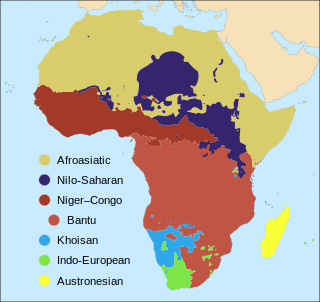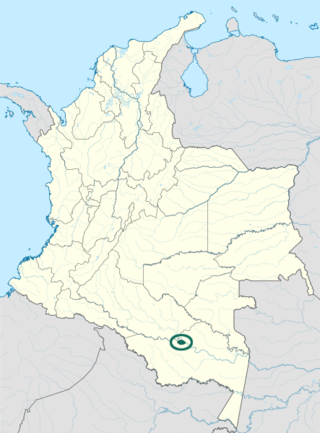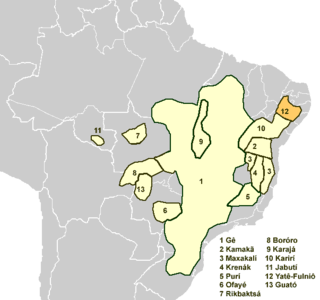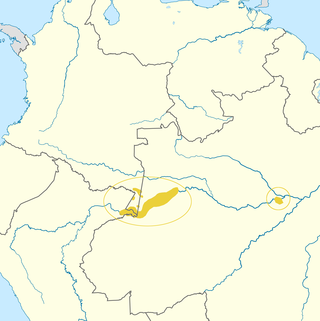Tone is the use of pitch in language to distinguish lexical or grammatical meaning—that is, to distinguish or to inflect words. All oral languages use pitch to express emotional and other para-linguistic information and to convey emphasis, contrast and other such features in what is called intonation, but not all languages use tones to distinguish words or their inflections, analogously to consonants and vowels. Languages that have this feature are called tonal languages; the distinctive tone patterns of such a language are sometimes called tonemes, by analogy with phoneme. Tonal languages are common in East and Southeast Asia, Africa, the Americas and the Pacific.

Thai, or Central Thai, is a Tai language of the Kra–Dai language family spoken by the Central Thai people, Mon in Central Thailand and the vast majority of Thai Chinese enclaves throughout the country. It is the sole official language of Thailand.

The number of languages natively spoken in Africa is variously estimated at between 1,250 and 2,100, and by some counts at over 3,000. Nigeria alone has over 500 languages, one of the greatest concentrations of linguistic diversity in the world. The languages of Africa belong to many distinct language families, among which the largest are:

The Indigenous languages of the Americas are the languages that were used by the Indigenous peoples of the Americas before the arrival of non-Indigenous peoples. Over a thousand of these languages are still used today, while many more are now extinct. The Indigenous languages of the Americas are not all related to each other, instead they are classified into a hundred or so language families, as well as a number of extinct languages that are unclassified due to the lack of information on them.
Kusaal is a Gur language spoken primarily in northern eastern Ghana, and Burkina Faso. It is spoken by about 121,000 people and takes its name from the Kusaal people, or Kusasi. There is a distinctive dialect division between Agole, to the East of the Volta River, and Toende, to the West. Agole has more speakers. The 6-district capital; Bawku West with Zebilla as capital and the rest; Binduri, Bawku, Tempane, Garu and Pusiga districts mostly Agole dialect speakers. The complete Bible translation is in the Agole dialect.
Máku, also spelled Mako, and in the language itself Jukude, is an unclassified language and likely language isolate once spoken on the Brazil–Venezuela border in Roraima along the upper Uraricoera and lower Auari rivers, west of Boa Vista, by the Jukudeitse. 300 years ago, the Jukude territory was between the Padamo and Cunucunuma rivers to the southwest.

Bora is an indigenous language of South America spoken in the western region of Amazon rainforest. Bora is a tonal language which, other than the Ticuna language, is a unique trait in the region.
Iau or Turu is a Lakes Plain language of West Papua, Indonesia, spoken by about 2,100 people, native speakers of this language are the Turu people (Iau). Most speakers are monolingual, and their number is growing. Other peoples in the western Lakes Plain area speak basic Iau. Iau is heavily tonal, with 11 tones on nouns and 19 simple and compound tones on verbs.

Murui Huitoto is an indigenous American Huitoto language of the Witotoan family. Murui is spoken by about 1,100 Murui people along the banks of the Putumayo, Cara-Paraná and Igara-Paraná rivers in Colombia. In Peru it is spoken in the North alongside the Ampiyacu and Napo rivers by some 1,000 people. Some Murui speakers live also outside their territories, for instance the vicinity of Leticia, Amazonas, Colombia.

Andoque is a language spoken by a few hundred Andoque people in Colombia, and is in decline. There were 10,000 speakers in 1908, down to 370 a century later, of which at most 50 are monolingual. The remaining speakers live in four residential areas in the region of the Anduche River, downstream from Araracuara, Solano, Caquetá, Colombia; the language is no longer spoken in Peru. Most speakers shifted to Spanish.
Irántxe /iˈɻɑːntʃeɪ/, also known as Mỹky (Münkü) or still as Irántxe-Münkü, is an indigenous language spoken by the Irántxe and Mỹky peoples in the state of Mato Grosso in Brazil. Recent descriptions of the language analyze it as a language isolate, in that it "bears no similarity with other language families". Monserrat (2010) is a well-reviewed grammar of the language.
Ticuna–Yuri is a small family, perhaps even a dialect continuum, consisting of at least two, and perhaps three, known languages of South America: the major western Amazonian language Ticuna, the poorly attested and extinct Yurí, and the scarcely known language of the largely uncontacted Carabayo. Kaufman also adds Munichi to the family.

Urarina is an language isolate spoken in Peru, specifically in the Loreto Region of Northwest Peru, by the Urarina people. There are around 3,000 speakers in Urarinas District. It uses a Latin script. It is also known as Itucali, Simacu or Shimacu.
Yurí (Jurí) is, or was, a language previously spoken near a stretch of the Caquetá River in the Brazilian Amazon, extending slightly into Colombia. It was spoken on the Puré River of Colombia, and the Içá River and Japurá River of Brazil.

Fulniô, or Yatê, is a language isolate of Brazil, and the only indigenous language remaining in the northeastern part of that country. The two dialects, Fulniô and Yatê, are very close. The Fulniô dialect is used primarily during a three-month religious retreat. Today, the language is spoken in Águas Belas, Pernambuco.
The Carabayo (Caraballo) language is spoken by the Carabayo people, also known as Yuri and Aroje, an uncontacted Amazonian people of Colombia living in at least three long houses, one of several suspected uncontacted peoples living along the Rio Puré in the southeastern corner of the country. They are known as the Aroje to the Bora people. Maku and Macusa are pejorative Arawak terms applied to many local languages, not anything specific to Carabayo. The name "Carabayo" is taken from a mock name, "Bernardo Caraballo", given to a Carabayo man during his captivity in the Capuchin mission at La Pedrera in 1969. It has been reported that their self-designation is Yacumo.
The Carabayo are an uncontacted people of Colombia living in at least three long houses, known as malokas, along the Rio Puré in the southeastern corner of the country. They live in the Amazonas Department of Colombian Amazon rainforest, near the border with Brazil. They share the protected National Park with the Passé and Jumana people.

The Ticuna are an indigenous people of Brazil (36,000), Colombia (6,000), and Peru (7,000). They are the most numerous tribe in the Brazilian Amazon.

The indigenous languages of the Americas form various linguistic areas or Sprachbunds that share various common (areal) traits.

The indigenous languages of South America are those whose origin dates back to the pre-Columbian era. The subcontinent has great linguistic diversity, but, as the number of speakers of indigenous languages is diminishing, it is estimated that it could become one of the least linguistically diverse regions of the planet.











